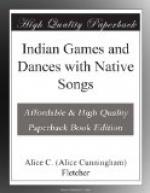To win the game the ball must be sent through a goal; to strike it so that it goes over or around the goal does not count. The ball must be made to take a straight line, to “make a straight path” through a goal, then the game is won. When a good shot is made, all on the side of the one who made the stroke should send up a shout. When the goal is won the winning side should give the victory cry of the game, “Ta-be!”
III
DOUBLE-BALL GAME
INTRODUCTORY NOTE.—Some stories credit the Moon as the giver of this game to the women, by whom it is exclusively played throughout the United States except among the tribes in Northern California, where the men use the game. There are indications that the Double-ball Game was known upon this continent in the remote past.
The peculiar ball employed for this game is composed of two small stuffed pouches connected by a band, or two billets of wood about five inches long, made like thick pegs with heads and ornamented on all sides with carvings; a leather thong five to eight inches long is attached at each end to the neck of each of the two billets. Dr. Culin reports an ingenious specimen made by the Maricopa Indians of Arizona; that double-ball is made from narrow strips of leather braided to form a band, each end of which is enlarged by braiding so as to make a ball, the finished article being about eight inches in length. (Ibid., p.665, Fig. 882.)
Properties.—One double-ball; as many sticks as players; red and yellow head-bands, equal in number, for the two sides of players.
Directions.—The double-ball should be made in camp in the following manner: A strip of leather or of strong, closely woven brown cloth from fifteen to twenty inches long. For six inches from both ends the strip should be about seven inches wide; the portion of the strip between these wide ends should be about three inches wide. The wide ends are to form the pouches, and the narrower middle section the band to connect the two pouches. The two edges of the strip should be lapped and strongly sewed the entire length of the strip, except a small opening about an inch long left on the side of each of the pouches. Through this opening the pouches are filled with dry sand, then the edges are securely sewed together so that no sand can escape. These pouches are the “balls.” The sides of the pouches should be decorated with designs painted in bright colors and a little tuft or tassel of red yarn fastened at the middle of the bottom of the pouch. The sticks should be about thirty-two inches long, not too heavy and somewhat pointed at one end that is slightly curved. Each stick should be marked by an individual device so that it can be claimed by its owner.
Two wickets, made by crotched poles about five and a half to six feet high, having a bar fastened across the top, are placed in line with each other, one at the East, the other at the West, and as far apart as the limits of the camp grounds will permit. A red streamer to be tied to the eastern wicket and a yellow streamer to the western wicket.




